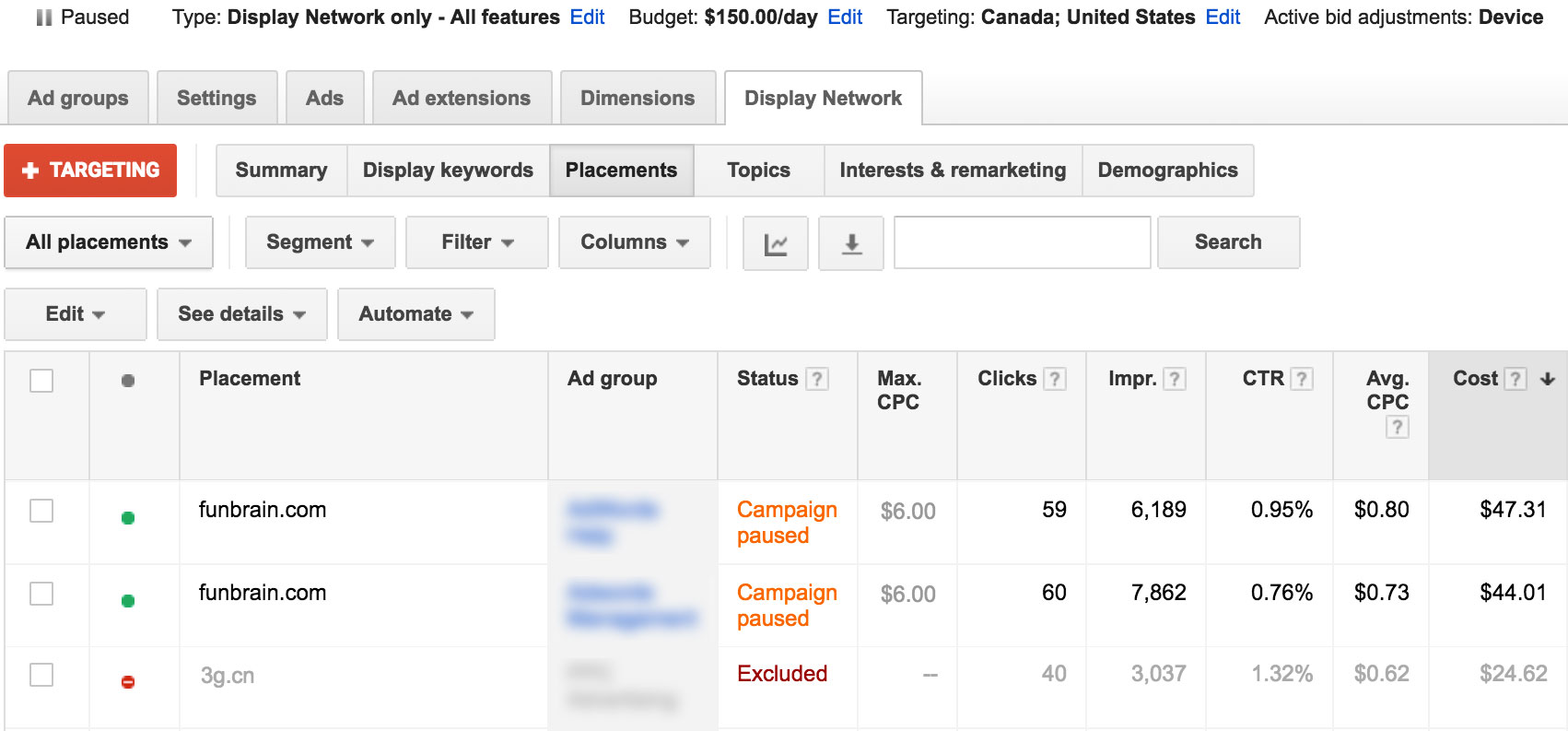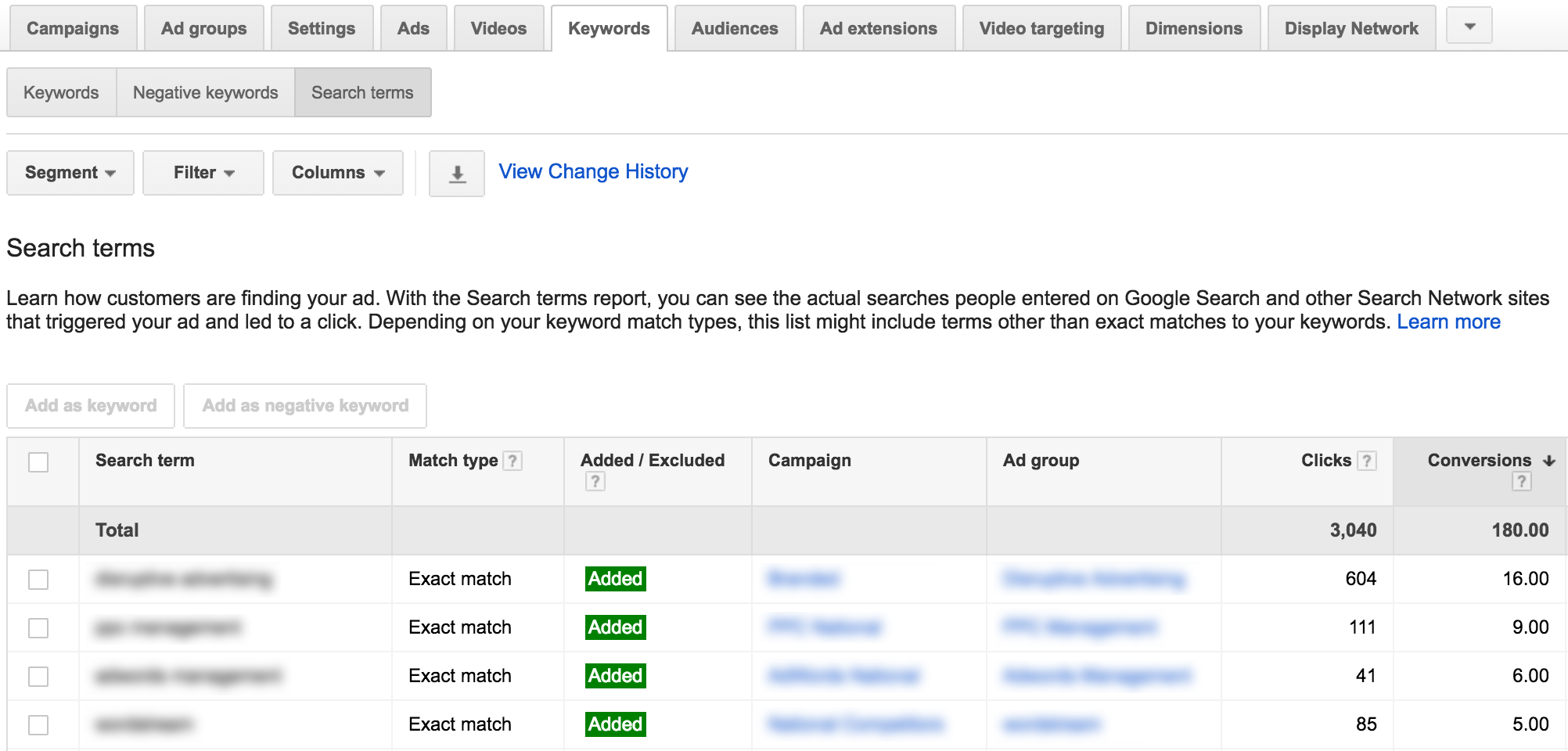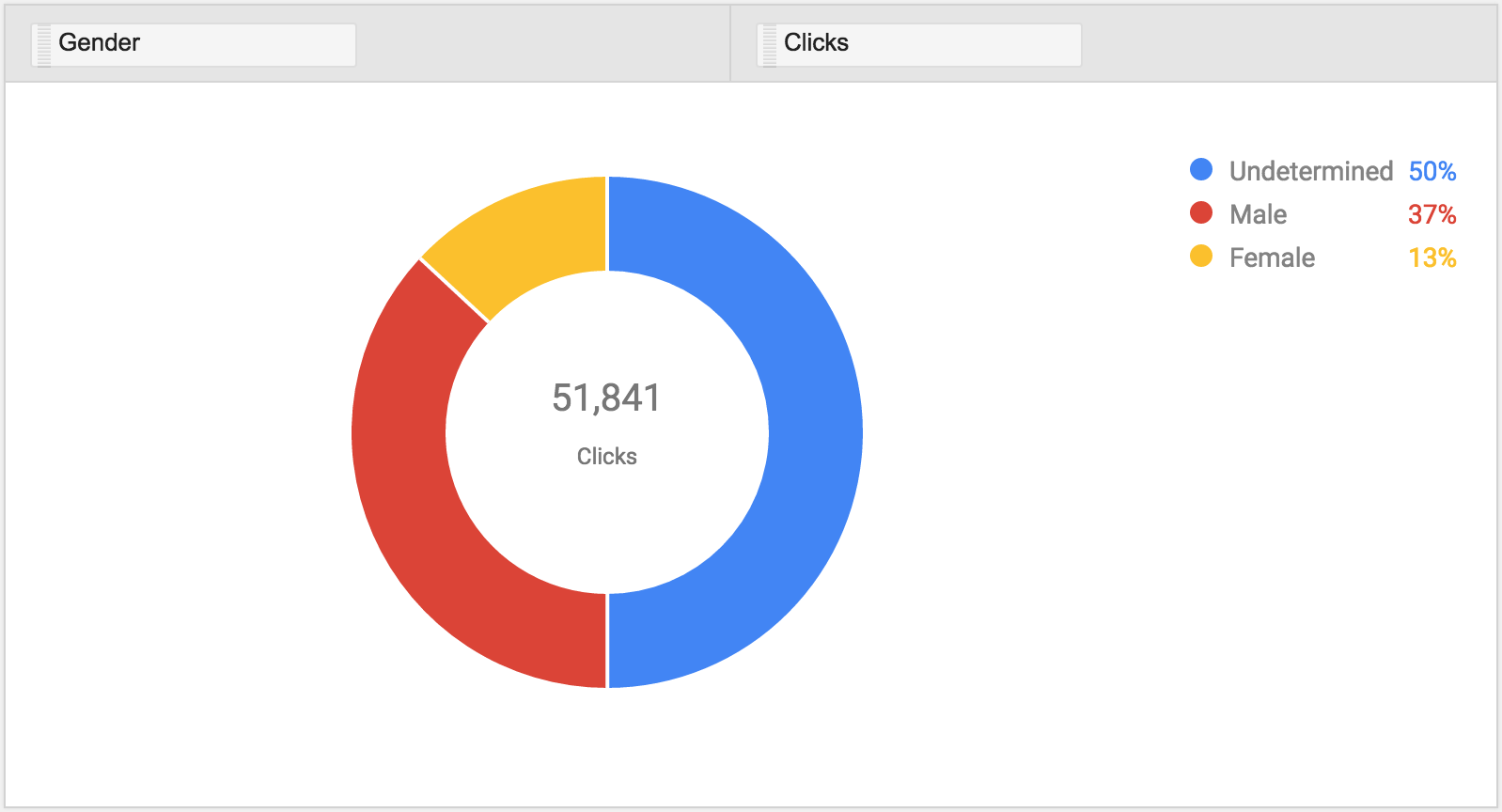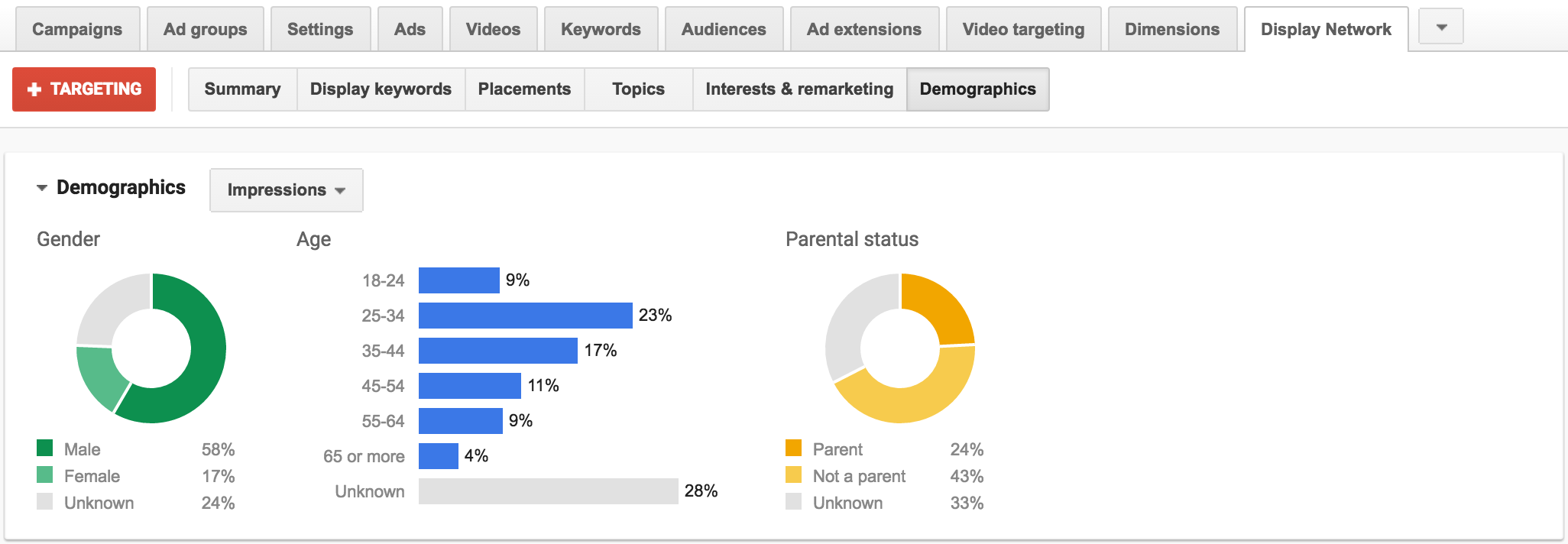Here’s a fun fact: In any given web session, your audience is more likely to have a heart attack than click on your banner ad.
Okay, so maybe that’s not so much a fun fact as it is a scary fact, but either way the fact is that most display ads have truly awful clickthrough rates.
The question is, why? Are your ads just unclickably ugly? Do you have the wrong CTAs? Is it just plain banner blindness?
While all of these elements could be contributing to a low clickthrough rate, often display ads struggle because they are simply showing up in front of the wrong audience.
Take this ad, for example:

Decent ad…terrifyingly bad placement.
However, with a little extra effort, your results can be better than this (admittedly, it’s not a very high bar). It’ll take a bit of work and research, but it will get your ads in front of more of the right people.
To improve the performance of your display ads, though, we’ll need to take a look at your analytics data. So, pull up your analytics platform and let’s get started!
Improving Your Topic/Interest Targeting
Topic/interest targeting is a very easy way to get your ads displayed on a ton of websites. However, if you don’t pick your topics carefully, your ads can easily end up in front of an irrelevant audience.
Imagine you’re marketing for a company like Slack, Salesforce or Moz. You’d probably choose a topic that your target audience is likely to be interested in, like “Business & Industrial > Advertising & Marketing > Marketing.”
Seems like a reasonable topic, right?
The only problem is, what your display network defines as a “Business & Industrial > Advertising & Marketing > Marketing” website may not be what you expect.
For example, www.getjar.com is one of the websites under this topic:

Now, I have nothing against GetJar, but if you’re marketing customer relationship management (CRM) software, your ideal audience probably doesn’t consist of people who want to hack Instagram accounts…
I’ll admit that I’ve been researching CRMs, so there’s a chance that Salesforce’s ad showed up because they were using an in-market audience to target people in a CRM purchasing pattern. However, even if this is the case, if I was on GetJar because I wanted to play “Toca Life Town perfect,” I’m not very likely to click on an ad for “The Complete Guide to Lead Nurturing.”
Sure, maybe I might click on an ad for “The Complete Guide to ‘Toca Life Town’ Nurturing”, but “The Complete Guide to Lead Nurturing”? Not so much.
Do you see the problem here? While topic/interest targeting can get you on a lot of supposedly relevant sites, the actual relevance of those sites to your company or ad is often very low.
The good news is, there’s an easy fix for problems like this.
Since most people use the Google Display Network, I’ll use the GDN for my examples, though the same principles apply to most display advertising platforms.
To begin, you need to figure out where exactly your ads are displaying. You can do this by opening AdWords, picking a reasonable time frame (like 6-12 weeks) and then selecting the campaign you’re interested in and clicking Display Network.
From there, click “Placements” and you can see where your ads are being displayed:

Just so you know, if you’ve already chosen certain specific sites that you want your ads displayed on, there will be a “Managed” status on those placements. Websites chosen by Google (from your targeting setting) have their status set as “Automatic”.
Once you’re here, sort by impressions or costs. Check the conversion rates of the traffic on the top websites you have listed and if you see a poor conversion rate, take a look at that website to see if it’s on that’s applicable to your business. If it doesn’t match your advertising goals, click on “Edit” and then exclude that site.
On the other hand, if you find a site with a great clickthrough or conversion rate, click on “+ Targeting” and add it to your list of managed placements. Yes, I know that sorting through and cleaning up your placements can take some extra time and effort, but it will greatly improve the effectiveness of your display ads.
Fixing Up Contextual Targeting
Contextual targeting takes a very different approach to display ad targeting. Instead of using topics or interests to identify the websites you want your ads on, with contextual targeting you create keyword lists that Google uses to identify relevant sites.
Of course, whether or not this approach is a good idea for your company depends wholly on your marketing goals and the keywords you choose.
In a lot of ways, picking the right keywords for contextual targeting is a lot like picking the right keywords for paid search advertising: you need to know what keywords and phrases your target audience searches for online. So, if you’re running a paid search campaign, some of your best data can be found in your search terms report.
You’ll be able to find this information by using a relevant time frame (of about 6-12 weeks) and clicking on the tab labeled “Keywords.” From there, click on “Search Terms”:

Sort this list by conversions, clicks or impressions to see which search queries bring in the best traffic.
Generally, most accounts will have groups of 5-10 search terms or keywords that are thematically similar and drive great results. Identify those search terms are build your contextual targeting keyword lists around those themes.
It will take Google about a month or two to find the best sites for you. Once that’s up and running, you can look through your placements list and see which sites are most worthwhile (like we did in the last section). Or, if you’re already running contextually targeted ads, you may want to look at your current placements and search terms list to make sure that you are currently targeting the right keywords in your display campaigns.
Again, this approach isn’t quite as easy as simply writing down all the possibly relevant keywords you can think of and using that list to target your display ads, but the results will be much better.
Refinining Demographic Targeting
Demographic targeting is one of the simplest display ad targeting methods to use, but it’s also one of the least effectively employed ways to improve your display advertising’s performance.
The majority of advertisers forget that they have demographic data they can use to help measure the performance of their ads. You can tell you have a problem with your targeting if your target audience is men over 50 but all of your ads are showing up for women under 30.
Sadly, this sort of problem is far more common than you might think.
To see if your demographic targeting makes sense, open up Google Analytics and select “Audience.” From there, expand the Demographics submenu and choose “Overview.”
Finally, change your segment to “Converters” and you’ll see a screen like this:

Looking at the results in this GIF, you can clearly see that this client shouldn’t be targeting display ads to people who are older than 44 or younger than 25. There are no real conversions coming from that audience.
By the way, this approach only works if you’re tracking conversions, so if you don’t have conversion tracking set up…change that now. However, even in this situation, you can still get some fantastic demographic information for target demographic insight from the AdWords Report Editor (assuming that you get a lot of high-quality traffic through paid search):

You can see here that this client gets about 3x more clicks from men than than they get from women. With that in mind, would it make sense to run a campaign that targets primarily women? Probably not.
Once you know the demographics of your audience, it’s time to compare those demographics to the demographics of your display advertising audience. Just open AdWords and click your chosen campaign, then choose “Display Network”. From there, choose the Demographics tab:

You can find insights on the gender, age and even the parental status of the people who convert from, click on or even just see your ads, courtesy of Google.
In this case, we’re looking at display ad demographic data for the same client as we saw in the other two screenshots. Comparing that data, it looks like their display ads are being shown to 3.4x more men than women, which matches the click demographics of the search ads they have set. That’s probably a good thing.
However, a significant portion of their impressions come from people over 44 and under 25. That’s a potential problem since that demographic doesn’t seem to convert on the client’s site. Limiting this client’s demographic targeting to people between 25 and 44 could significantly improve their ad performance.
Unlike the last two tactics, this approach is very easy to implement, so take a look at your demographic data and figure out where your best value comes from!
Conclusion
With the right targeting, you can get your display ads in front of the right audience. That can be great for building brand awareness and driving relevant clicks and conversions.
Or, your ads could be showing up in situations like this:

However, by using your analytics data, you can put together a good advertising strategy that can get your display ads to the right audience and boost the odds that your display ads will get clicked.
You’ve heard my two cents, now I want to hear yours.
How do you improve display ad performance? Have you ever seen any heart attack-inducing display ad fails like these?
About the Author: Jacob Baadsgaard is the CEO and fearless leader of Disruptive Advertising, an online marketing agency dedicated to using PPC advertising and website optimization to drive sales. His face is as big as his heart and he loves to help businesses achieve their online potential. Connect with him on LinkedIn or Twitter.
No comments:
Post a Comment